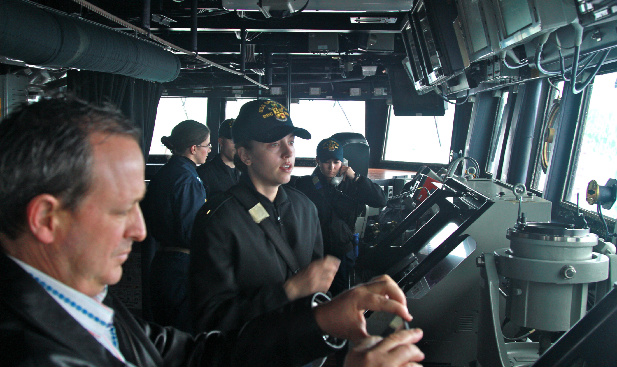 R2-D2 can bring the heat
R2-D2 can bring the heat
Editor Note: This is Part 3 of the Navy Destroyer USS Spruance story- you can also view Part I and Part II As we began our tour we were clearly reminded of what we were told before we entered the ship but had all but forgotten; the interior of the ship is pressurized, like an aircraft. You open a hatch, enter a small area that will hold at most 8 or 9 people, in some cases only 2-3, close the hatch behind you and then open the other hatch to enter or exit the interior. Why? It prevents a very large, thick, heavy steel door from giving you a major body slam and breaking multiple parts of your body, likely starting with your nose. The difference in pressure, although it is only 2 PSI, is enough to do that. We all quickly became experts in hatch protocol. The interior is pressurized as a defense against chemical, biological or nuclear agents. The exterior structure of the ship is covered in sprinklers, giving her the ability to completely wash herself down with sea water and then fresh water in the event of any such type of attack. Like all great plans, inventions and intentions, there are unintended consequences and the pressurization of the ship is no exception. An unplanned but very positive effect of the pressurization is that every time those hatches are used to exit the interior, minute particles of dust and dirt get blown out. The result is an exceptionally clean ship, complimenting the work of the crew in that area.  20MM Armor piercing rounds @ 4500 rounds/minute means you never have to ask a bad guy to behave twice We left the interior and followed the Ensign to the forward deck. Walking out on deck, the first thing that you notice is the wind, most of it generated by the speed of the ship. Second, you notice that walking towards the bow is decidedly uphill. We gathered around the 5” gun near the bow. The size refers to the diameter of the projectile. The gun fires 6 different types of ammunition (multiple surface to air and surface to surface shells) and is fully automated. Going to the bow, you step around the chains of not one, but two anchors. The main anchor is 4,000 pounds and it is not the anchor itself that holds the ship, it is the anchor chain which weighs even more. The second anchor is the “hurricane” anchor, it weighs 5,000 pounds and is angled off the port side due to the Coriolis effect (clockwise movement) of hurricanes in the northern hemisphere.
20MM Armor piercing rounds @ 4500 rounds/minute means you never have to ask a bad guy to behave twice We left the interior and followed the Ensign to the forward deck. Walking out on deck, the first thing that you notice is the wind, most of it generated by the speed of the ship. Second, you notice that walking towards the bow is decidedly uphill. We gathered around the 5” gun near the bow. The size refers to the diameter of the projectile. The gun fires 6 different types of ammunition (multiple surface to air and surface to surface shells) and is fully automated. Going to the bow, you step around the chains of not one, but two anchors. The main anchor is 4,000 pounds and it is not the anchor itself that holds the ship, it is the anchor chain which weighs even more. The second anchor is the “hurricane” anchor, it weighs 5,000 pounds and is angled off the port side due to the Coriolis effect (clockwise movement) of hurricanes in the northern hemisphere.  “As a matter of fact, the U.S. Navy IS a Global Force for Good. Thanks for asking.” With a little rain and wind battering us, we then proceed down the port side of the ship to amidships, climb up a ladder, walk towards the stern, go up another ladder and get an overview from the Ensign of the machinery just above our heads, more accurately the machine gun above our heads, and not just any machine gun. Sometimes affectionately referred to as “R2D2” due to a distinctive shape, (ed: top photo) the CIWS Gatling gun is an automated anti-missile weapon capable of firing 75 rounds of 20mm armor piercing rounds a second. Yes, 75 a second…4,500 rounds a minute. The weather continues unabated and we neither much notice nor care. We traverse back down the ladders, into the outer walkway of the ship, through one of the two helicopter hangers and then back out, this time onto the flight deck, the one we landed on that morning. Besides a gray sea with our beautiful teal blue wake cutting through it, we see the 2 sets of MK46 Triple Torpedo Tube Launchers, defense against enemy submarines. There is a lot of firepower on this destroyer and we haven’t even seen the real cool stuff yet, but we have seen it’s home, multiple rows of missile tubes fore and aft abound. And we can’t wait to see what we can do with those.
“As a matter of fact, the U.S. Navy IS a Global Force for Good. Thanks for asking.” With a little rain and wind battering us, we then proceed down the port side of the ship to amidships, climb up a ladder, walk towards the stern, go up another ladder and get an overview from the Ensign of the machinery just above our heads, more accurately the machine gun above our heads, and not just any machine gun. Sometimes affectionately referred to as “R2D2” due to a distinctive shape, (ed: top photo) the CIWS Gatling gun is an automated anti-missile weapon capable of firing 75 rounds of 20mm armor piercing rounds a second. Yes, 75 a second…4,500 rounds a minute. The weather continues unabated and we neither much notice nor care. We traverse back down the ladders, into the outer walkway of the ship, through one of the two helicopter hangers and then back out, this time onto the flight deck, the one we landed on that morning. Besides a gray sea with our beautiful teal blue wake cutting through it, we see the 2 sets of MK46 Triple Torpedo Tube Launchers, defense against enemy submarines. There is a lot of firepower on this destroyer and we haven’t even seen the real cool stuff yet, but we have seen it’s home, multiple rows of missile tubes fore and aft abound. And we can’t wait to see what we can do with those.
Navy Destroyer USS Spruance Part III: R2D2 And Avoiding Broken Noses
By Techli
19 febrero, 2013









